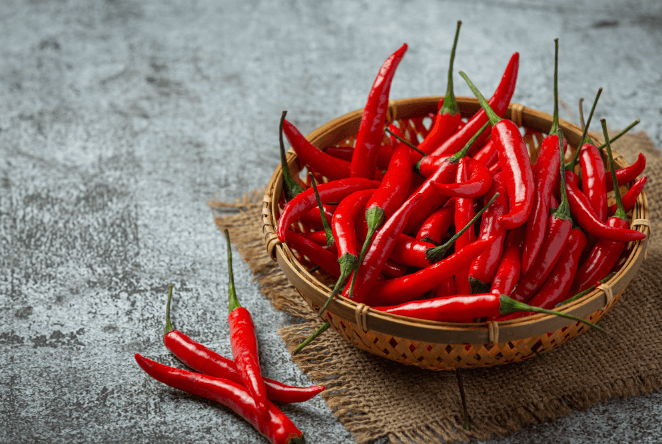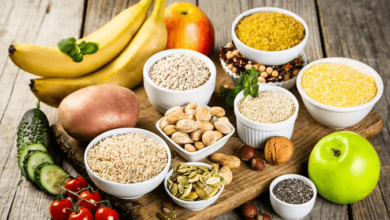RED CHILLI YOU SHOULD KNOW ABOUT RED CHILLI USES BENEFITS, SIDE EFFECTS

Red chilli is a spice used centuries to flavour dishes and adds heat to meals. It’s a staple ingredient in many cuisines worldwide, from Indian curries to Mexican salsas. But did you know that red chillies are delicious and good for your health? In this blog post, we’ll explore all there is to know about red chilli – its uses, benefits, side effects, and how to incorporate it into your diet. So whether you’re a seasoned chef or someone who loves spicy food, read on to discover everything you should know about this fiery pepper!
What is red chilli?
Red chilli, also known as cayenne or chilli pepper, is a spice from the fruit of plants belonging to the Capsicum annuum family. It’s usually dried and ground into powder or used fresh in dishes.
Red chillies vary in heat levels depending on their Scoville rating – a measure of how hot they are. Some varieties can be incredibly spicy, while others have a milder flavour.
Aside from its use as a spice, red chilli has been used for medicinal purposes for hundreds of years. It contains capsaicin which gives it its characteristic spiciness and has anti-inflammatory properties that may help relieve pain and digestion.
Red chilli is considered an aphrodisiac in some cultures due to its ability to increase blood flow and heart rate. This versatile spice adds flavour and depth to many savoury dishes while providing potential health benefits.
Red chilli uses
Red chilli is a versatile spice that can be used in various ways to add flavour and heat to dishes. One of the most common uses of red chilli is as a seasoning for meats, vegetables, soups, stews and curries.
Red chilli can also make homemade hot sauces by blending it with vinegar, water and other spices or ingredients. It can also be added to marinades for an extra kick.
Another widespread use of red chilli is in pickling. Combining red chillies with vinegar, salt, and other seasonings allows you to create spicy pickled vegetables that are perfect as toppings or condiments.
In addition to cooking applications, some people use red chilli as a natural remedy for specific health conditions. Red chillies contain capsaicin which has been shown to have anti-inflammatory properties that may help relieve pain associated with arthritis or muscle soreness.
Whether you’re looking to add some heat to your meals or seeking the potential health benefits of capsaicin, there are plenty of uses for red chilli in your daily life.
Red chilli benefits
Red chilli is more than just a spice that adds heat to our food. It also has numerous health benefits, making it an essential addition to our diet. One of the most well-known benefits of red chilli is its ability to boost metabolism and aid in weight loss.
Capsaicin, the compound responsible for the spicy flavour of red chillies, can increase thermogenesis – a process where the body burns calories to produce heat. This can lead to increased fat-burning and weight loss over time.
But that’s not all! Red chillies are also loaded with antioxidants such as vitamin C, which can help protect against cell damage caused by free radicals. Additionally, research suggests that capsaicin may have anti-inflammatory properties and could potentially help reduce pain caused by conditions like arthritis.
Red chillies may even be beneficial for heart health. Studies have shown that consuming red chilli peppers regularly can lower blood pressure and cholesterol levels and reduce the risk of heart disease.
Incorporating red chillies into your diet can provide various health benefits beyond just adding flavour to your meals. So go ahead – add some spice to your life!
Red chilli side effects
While red chilli is a popular spice used in many cuisines worldwide, it’s essential to understand that consuming too much can have some side effects on our health. One of the most common side effects is digestive issues such as heartburn, acid reflux and stomach ulcers. This is because red chilli contains capsaicin which can irritate our stomach lining.
Another potential side effect of consuming red chilli is allergic reactions. Some people may be allergic to this spicy pepper, and if consumed in large amounts or regularly, it could result in symptoms like hives, difficulty breathing and swelling.
In addition to these possible health concerns, excessive consumption of red chilli could also lead to other problems, such as dehydration due to increased sweating or even skin irritation from handling them without gloves. Individuals with sensitive skin or allergies must take extra precautions when running and consuming this spicy ingredient.
While moderate consumption of red chilli does not typically cause major health issues for most people, it’s still important to be aware of its potential side effects to make informed decisions about how much you consume.
How to use red chilli
Red chilli is a versatile spice used in various dishes to add flavour and heat. Here are some ways you can use red chilli:
- In curries: Red chillies are common in many Indian curries. They add heat and colour to the dish.
- In marinades: Crushed red pepper flakes or dried red chillies can be added to marinades for meat, poultry or seafood for an extra kick of flavour.
- In salsa: Fresh chopped red chillies can be mixed with tomatoes, onions, cilantro and lime juice to create a spicy salsa that pairs well with chips or grilled meats.
- In stir-fries: Add sliced fresh red chillies towards the end of cooking your stir-fry for some added heat.
- As a garnish: Sliced fresh or dried whole red chillies make beautiful garnishes on top of soups, salads, and cocktails!
Always carefully handle chilli peppers as they contain capsaicin, which irritates if it gets into your eyes or skin!
Recipes with red chilli
Red chilli is a versatile ingredient in various dishes to add flavour and spice. Here are some delicious recipes with red chilli!
Firstly, you can make a spicy stir-fry by heating some oil in a pan and adding chopped red chillies, garlic, ginger and your choice of vegetables or protein. Stir-fry until cooked through and serve over rice.
Another recipe idea is to make salsa using fresh tomatoes, onions, lime juice and chopped red chillies. This spicy dip goes well with tortilla chips or as a topping for grilled meats.
If you’re feeling adventurous, try making hot sauce at home! Blend cooked red chillies, vinegar, salt and sugar to taste for a homemade condiment that packs a punch.
Why not add some heat to your morning eggs? Whisk together eggs and milk before cooking them in butter with chopped red chillies for an extra kick of flavour.
These are just a few ideas for incorporating the bold taste of red chilli into your meals. Experiment with different recipes to find your favourite way of using this fiery ingredient!
Conclusion
Red chilli is a versatile ingredient that can add flavour and heat to any dish. From Indian curries to Mexican salsas, this spice has been used in cuisines worldwide for centuries. Not only does it enhance the taste of food, but it also provides numerous health benefits, such as boosting metabolism and aiding digestion.
However, like any other ingredient or supplement, excessive red chilli consumption can adversely affect your health. It’s essential to use this spice in moderation and always consult with a healthcare provider if you have any underlying conditions.
In summary, incorporating red chilli into your diet can elevate your culinary experience while providing various health advantages. So go ahead and experiment with different recipes using this fiery little pepper!




